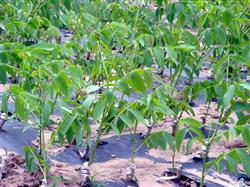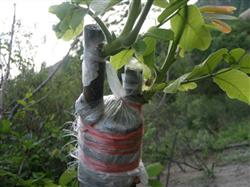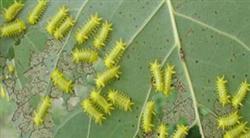What if the walnut tree doesn't hang its fruit?

Walnut trees do not hang fruit, which can be solved by high grafting and replacement, and can produce good benefits. The main techniques of high grafting of walnut trees are as follows: the grafting of walnut trees is generally 5-15 years old with low stem, small crown and exuberant growth. At the same time, large trees less than 30 years old and young trees with a trunk diameter less than 1.5 cm can also be reconnected. If it is a weak tree, it is necessary to strengthen the management and wait for the tree to be rejuvenated before grafting. The scion should be taken from the middle or base part of the developing branch of the hanging fruit tree with good variety, strong growth and no diseases and insect pests, the diameter is more than 1 cm, and the pith is small and smooth. The suitable time for ear harvest is from the time of defoliation to the middle of February of the following year. Each scion keeps 3 full buds, sealed with paraffin wax, tied up with 50 or 100 varieties, buried with wet sand or wet sawdust, 15-20 cm thick, stored in a place with a temperature of about 10 degrees Celsius. The suitable time for high grafting and replacement of walnut should be controlled at the time of tree bud germination or leaf initial expansion. The bleeding should be controlled by sawing the joint according to the original crown affiliation 7 days before grafting, and the saw head should be 20-30 cm away from the base. At the same time, at the base of the trunk 20-30 cm from the ground, the screw drill 2-3 openings, the depth is 1/5 to 1/7 of the trunk diameter, in order to facilitate the outflow. If there is too much wound flow, you can also saw 1-2 wound orifices at the base of the joint. Grafting technique, skin grafting. The scion is not peeled, and the diameter of the rootstock is 3-12 cm. Insert skin and tongue. This method is mainly used for scion peeling and rootstock interface diameter of 3-12 cm. When grafting, saw off the dry layer of the rootstock, then cut off the outer skin of the rootstock with a long tongue, cut the scion to grow 5-6 cm tongue-shaped cutting surface, and pinch off the cortex and xylem of the tongue-like part with your hand, and then insert the ligulate part of xylem between the cortex and xylem on one side of the cross-section of the rootstock, so that the tongue-like skin layer of the scion is applied on the tongue-shaped cutting surface of the rootstock cortex, and finally tightly bound with plastic straps. Double tongue connection. Rootstock interface diameter less than 3 cm is used. The method of fastening the spike. The rootstock is too thick and the phloem is too thick. After the wound protection scion is fixed, the interface should be moisturized. Generally, the grafting joint and scion should be completely covered with grafting tape, wax or plastic bag, and the plastic bag should be 4-5 cm higher than the top of the scion, and the gas should be removed to facilitate the scion to germinate and shoot. Tie it up and down with a newspaper cover outside the plastic bag to protect the shade, moisturize and keep warm, and promote wound healing. After grafting management, when the scion begins to sprout and branch and expand leaves after grafting, observe every 2-3 days, the top of the plastic bag can be made a small opening to let the tip of the shoot protrude. The top vent from small to large, can not be opened at one time, let alone remove the plastic bag prematurely. Remove the germinating branches of the rootstock in time for degermination. If the joint is not alive, 2-3 germinating branches can be retained in the appropriate part and then replaced. 25-30 days after anti-folding grafting, the scion sprouted one after another and grew rapidly. When the scion grows slightly to about 30cm, set up a pillar at the interface in time, tie the new slightly to the pillar, and cut out the sprouting on the branch at any time, and tie it up a little 2-3 times with the lengthening of the new branch. If the scion did not survive, the suitable position should be selected, 2-3 tillers should be sprouted on the rootstock, and the bud grafting should be carried out from July to August. After 2-3 months of loosening and grafting, the interface binding material should be relaxed once, but can not be removed. It can be removed after late August according to the situation. High-grafted walnut trees are easy to form clumpy branches, so we should combine short cutting and thinning branches, expand the crown as quickly as possible, and strengthen fertilizer and water management and pest control so that it can be put into production as soon as possible.
- Prev

Grafting and pruning of Walnut trees
Pruning method of trees in full fruit pruning of walnut trees refers to pruning in a broad sense, that is, both pruning and pruning. Trees of different ages have different pruning tasks. The pruning of young trees is to continue to cultivate and maintain the shape of high-yielding trees on the basis of shaping, while the pruning of primary fruit trees is to continue to cultivate backbone branches at all levels and make full use of auxiliary branches.
- Next

Scientific planting techniques of walnut seedlings and walnut trees
The yellow diamondback moth has one generation a year in the north and two generations in the Yangtze River valley. The mature larvae after autumn often spin silk and form hard cocoons on branches, petioles and even leaves to survive the winter. The cocoon is oval, grayish white, with several brown longitudinal bands, shaped like sparrow eggs. In early summer of the following year, mature larvae pupate in the cocoon, and the Eclosion adult flies out 1 month later.
Related
- Moge, come on! The staff of the peasant association in the producing area of cantaloupe were frightened when the crowd gathered.
- Causes and Solutions of low Fruit setting rate of Apple
- Symptoms and control measures of passion fruit virus disease
- Fruit growing lesson: how do apple orchards keep high yields?
- Can you build orchards in the mountains? What are the pros and cons?
- How to manage the coloring period of Crisson grape?
- This paper introduces the processing technology of two kinds of fig products.
- How much is a month for retired teachers in rural areas by 2020?
- How can strawberry planting increase sugar content? We should pay attention to management in many aspects.
- What are the cultivation techniques on how to improve the yield of golden fruit?

